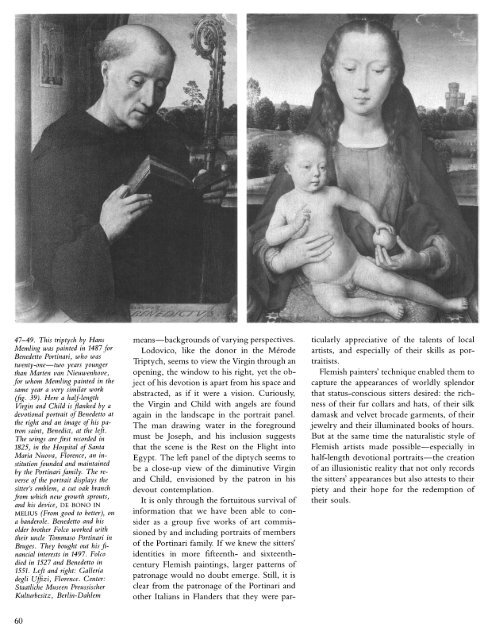Early Flemish Portraits 1425-1525: The Metropolitan Museum of Art ...
Early Flemish Portraits 1425-1525: The Metropolitan Museum of Art ...
Early Flemish Portraits 1425-1525: The Metropolitan Museum of Art ...
You also want an ePaper? Increase the reach of your titles
YUMPU automatically turns print PDFs into web optimized ePapers that Google loves.
47-49. This triptych by Hans<br />
Memling was painted in 1487 for<br />
Benedetto Portinari, who was<br />
twenty-one-two years younger<br />
than Marten van Nieuwenhove,<br />
for whom Memling painted in the<br />
same year a very similar work<br />
(fig. 39). Here a half-length<br />
Virgin and Child is flanked by a<br />
devotional portrait <strong>of</strong> Benedetto at<br />
the right and an image <strong>of</strong> his patron<br />
saint, Benedict, at the left.<br />
<strong>The</strong> wings are first recorded in<br />
1825, in the Hospital <strong>of</strong> Santa<br />
Maria Nuova, Florence, an institution<br />
founded and maintained<br />
by the Portinari family. <strong>The</strong> reverse<br />
<strong>of</strong> the portrait displays the<br />
sitter's emblem, a cut oak branch<br />
from which new growth sprouts,<br />
and his device, DE BONO IN<br />
MELIUS (From good to better), on<br />
a banderole. Benedetto and his<br />
older brother Folco worked with<br />
their uncle Tommaso Portinari in<br />
Bruges. <strong>The</strong>y bought out his financial<br />
interests in 1497. Folco<br />
died in 1527 and Benedetto in<br />
1551. Left and right: Galleria<br />
degli Uffizi, Florence. Center:<br />
Staatliche Museen Preussischer<br />
Kulturbesitz, Berlin-Dahlem<br />
means-backgrounds <strong>of</strong> varying perspectives.<br />
Lodovico, like the donor in the Merode<br />
Triptych, seems to view the Virgin through an<br />
opening, the window to his right, yet the object<br />
<strong>of</strong> his devotion is apart from his space and<br />
abstracted, as if it were a vision. Curiously,<br />
the Virgin and Child with angels are found<br />
again in the landscape in the portrait panel.<br />
<strong>The</strong> man drawing water in the foreground<br />
must be Joseph, and his inclusion suggests<br />
that the scene is the Rest on the Flight into<br />
Egypt. <strong>The</strong> left panel <strong>of</strong> the diptych seems to<br />
be a close-up view <strong>of</strong> the diminutive Virgin<br />
and Child, envisioned by the patron in his<br />
devout contemplation.<br />
It is only through the fortuitous survival <strong>of</strong><br />
information that we have been able to consider<br />
as a group five works <strong>of</strong> art commissioned<br />
by and including portraits <strong>of</strong> members<br />
<strong>of</strong> the Portinari family. If we knew the sitters'<br />
identities in more fifteenth- and sixteenthcentury<br />
<strong>Flemish</strong> paintings, larger patterns <strong>of</strong><br />
patronage would no doubt emerge. Still, it is<br />
clear from the patronage <strong>of</strong> the Portinari and<br />
other Italians in Flanders that they were par-<br />
ticularly appreciative <strong>of</strong> the talents <strong>of</strong> local<br />
artists, and especially <strong>of</strong> their skills as portraitists.<br />
<strong>Flemish</strong> painters' technique enabled them to<br />
capture the appearances <strong>of</strong> worldly splendor<br />
that status-conscious sitters desired: the richness<br />
<strong>of</strong> their fur collars and hats, <strong>of</strong> their silk<br />
damask and velvet brocade garments, <strong>of</strong> their<br />
jewelry and their illuminated books <strong>of</strong> hours.<br />
But at the same time the naturalistic style <strong>of</strong><br />
<strong>Flemish</strong> artists made possible-especially in<br />
half-length devotional portraits-the creation<br />
<strong>of</strong> an illusionistic reality that not only records<br />
the sitters' appearances but also attests to their<br />
piety and their hope for the redemption <strong>of</strong><br />
their souls.<br />
60

















